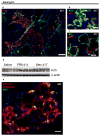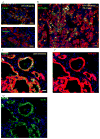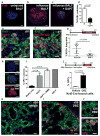Lineage-negative progenitors mobilize to regenerate lung epithelium after major injury
- PMID: 25533958
- PMCID: PMC4312207
- DOI: 10.1038/nature14112
Lineage-negative progenitors mobilize to regenerate lung epithelium after major injury
Abstract
Broadly, tissue regeneration is achieved in two ways: by proliferation of common differentiated cells and/or by deployment of specialized stem/progenitor cells. Which of these pathways applies is both organ- and injury-specific. Current models in the lung posit that epithelial repair can be attributed to cells expressing mature lineage markers. By contrast, here we define the regenerative role of previously uncharacterized, rare lineage-negative epithelial stem/progenitor (LNEP) cells present within normal distal lung. Quiescent LNEPs activate a ΔNp63 (a p63 splice variant) and cytokeratin 5 remodelling program after influenza or bleomycin injury in mice. Activated cells proliferate and migrate widely to occupy heavily injured areas depleted of mature lineages, at which point they differentiate towards mature epithelium. Lineage tracing revealed scant contribution of pre-existing mature epithelial cells in such repair, whereas orthotopic transplantation of LNEPs, isolated by a definitive surface profile identified through single-cell sequencing, directly demonstrated the proliferative capacity and multipotency of this population. LNEPs require Notch signalling to activate the ΔNp63 and cytokeratin 5 program, and subsequent Notch blockade promotes an alveolar cell fate. Persistent Notch signalling after injury led to parenchymal 'micro-honeycombing' (alveolar cysts), indicative of failed regeneration. Lungs from patients with fibrosis show analogous honeycomb cysts with evidence of hyperactive Notch signalling. Our findings indicate that distinct stem/progenitor cell pools repopulate injured tissue depending on the extent of the injury, and the outcomes of regeneration or fibrosis may depend in part on the dynamics of LNEP Notch signalling.
Figures














Comment in
-
Stem cells: Emergency back-up for lung repair.Nature. 2015 Jan 29;517(7536):556-7. doi: 10.1038/517556a. Nature. 2015. PMID: 25631438 No abstract available.
-
Tracing the potential of lung progenitors.Nat Biotechnol. 2015 Feb;33(2):152-4. doi: 10.1038/nbt.3139. Nat Biotechnol. 2015. PMID: 25658282 Free PMC article.
-
Delineating the hierarchy of lung progenitor cells and their response to influenza.Eur Respir J. 2015 Aug;46(2):315-7. doi: 10.1183/09031936.00011915. Eur Respir J. 2015. PMID: 26232479 No abstract available.
References
Publication types
MeSH terms
Substances
Associated data
- Actions
Grants and funding
LinkOut - more resources
Full Text Sources
Other Literature Sources
Medical
Molecular Biology Databases
Research Materials

